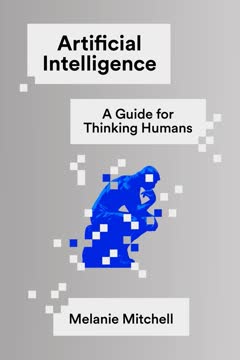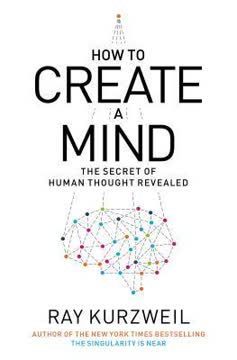Key Takeaways
1. The Law of Accelerating Returns: Technology progresses exponentially
The future will be far more surprising than most observers realize because few have truly internalized the implications of the fact that the rate of change itself is accelerating.
Exponential growth. The pace of technological progress is not linear but exponential. This means that the rate of advancement itself is increasing over time. For example, the power and price-performance of computing have been doubling approximately every 18 months (Moore's Law), and similar exponential trends can be observed in various fields such as genetics, nanotechnology, and artificial intelligence.
Implications for the future. This accelerating pace of change has profound implications for the future of humanity. As technology progresses exponentially, we can expect to see more dramatic changes in shorter periods. This rapid acceleration will lead to technological breakthroughs that may seem like science fiction today but could become reality within decades. Some key areas affected by this exponential growth include:
- Computing power and artificial intelligence
- Biotechnology and genetic engineering
- Nanotechnology and materials science
- Energy production and storage
- Space exploration and colonization
2. Genetics, Nanotechnology, and Robotics: The three overlapping revolutions
The overlapping GNR revolutions will bring about numerous changes in our world, including the creation of greater-than-human intelligence.
Genetics. The genetics revolution involves understanding and manipulating the code of life. This includes advancements in:
- Gene therapy
- Personalized medicine
- Synthetic biology
- Cloning and stem cell research
Nanotechnology. The nanotechnology revolution focuses on manipulating matter at the atomic and molecular scale. Key areas include:
- Molecular manufacturing
- Smart materials
- Nanorobots for medical applications
- Environmental remediation
Robotics and AI. The robotics revolution encompasses the development of artificial intelligence and advanced robotics. This includes:
- Machine learning and deep neural networks
- Natural language processing
- Computer vision and pattern recognition
- Autonomous systems and robots
These three revolutions are interconnected and mutually reinforcing. As they progress, they will lead to unprecedented capabilities in redesigning biological systems, creating intelligent machines, and manipulating matter at the nanoscale.
3. The Singularity: When artificial intelligence surpasses human intelligence
The Singularity will represent the culmination of the merger of our biological thinking and existence with our technology, resulting in a world that is still human but that transcends our biological roots.
Definition and implications. The Singularity refers to a hypothetical future point when artificial intelligence surpasses human intelligence, leading to a rapid and unpredictable transformation of civilization. This event is expected to result in an intelligence explosion, where AI systems can improve themselves at an accelerating rate, far outpacing human cognitive abilities.
Potential outcomes. The Singularity could lead to:
- Superhuman AI systems capable of solving complex global problems
- Merger of human and machine intelligence
- Radical life extension or even immortality
- Transformation of the physical world through advanced nanotechnology
- Expansion of consciousness and new forms of experience
While the concept of the Singularity is exciting, it also raises concerns about the potential risks and ethical implications of creating superintelligent machines. Ensuring that advanced AI systems align with human values and interests will be crucial as we approach this technological watershed.
4. Brain Reverse Engineering: Understanding and replicating human cognition
We are already in a position to create detailed and realistic models of all brain regions, and within two decades, we will have the requisite hardware to emulate human brain functionality.
Mapping the brain. Advances in brain imaging technologies, such as fMRI and optogenetics, are allowing scientists to map the structure and function of the human brain with unprecedented detail. This growing understanding of neural networks and cognitive processes is paving the way for the development of more sophisticated artificial intelligence systems.
Emulating brain function. As our knowledge of the brain increases, researchers are working to create computer models that can replicate various aspects of human cognition. This includes:
- Neural network architectures inspired by brain structure
- Algorithms that mimic human learning and decision-making processes
- Systems that can process sensory information in ways similar to the human brain
The ultimate goal of brain reverse engineering is to create artificial intelligence systems that can match or exceed human cognitive abilities across a wide range of tasks. This could lead to the development of AI systems with human-like general intelligence, capable of reasoning, problem-solving, and creativity on par with or beyond human capabilities.
5. The Future of Human Biology: Merging with non-biological intelligence
We are beginning to understand aging, not as a single inexorable progression but as a group of related processes. Strategies are emerging for fully reversing each of these aging progressions.
Enhancing human biology. As technology advances, we will have increasing opportunities to augment and improve our biological systems. This includes:
- Genetic engineering to eliminate diseases and enhance capabilities
- Neural implants to boost cognitive functions
- Nanotechnology-based therapies for cellular repair and regeneration
The transhuman transition. Eventually, the line between biological and non-biological intelligence may blur, leading to a transhuman condition where humans integrate more closely with advanced technologies. This could involve:
- Direct brain-computer interfaces
- Uploading human consciousness to digital substrates
- Hybrid biological-technological bodies
These developments raise profound questions about the nature of human identity and consciousness, as well as ethical concerns about equality and access to enhancement technologies.
6. Overcoming the Limits of Biology: Radical life extension and enhancement
We can reprogramme our biochemistry away from disease and aging.
Extending lifespan. Advances in biotechnology and nanotechnology are opening up new possibilities for radically extending human lifespan. Key approaches include:
- Telomere extension to slow cellular aging
- Stem cell therapies for tissue regeneration
- Nanorobots for cellular repair and maintenance
- Genetic therapies to target age-related diseases
Enhancing human capabilities. Beyond extending lifespan, future technologies may allow for significant enhancements to human physical and cognitive abilities. This could include:
- Augmented sensory perception
- Enhanced memory and processing speed
- Improved physical strength and endurance
- Resistance to environmental hazards and diseases
These advancements raise ethical questions about the nature of humanity and the potential for creating new forms of inequality based on access to enhancement technologies.
7. The Evolution of Artificial Intelligence: From narrow AI to strong AI
An important threshold will be achieved when a computer wins the Turing test, being able to fool a human judge into believing it's human.
Narrow AI. Current AI systems are considered "narrow" or "weak" AI, designed to perform specific tasks within limited domains. Examples include:
- Image and speech recognition systems
- Game-playing AI (e.g., chess and Go)
- Recommendation algorithms
- Autonomous vehicles
Strong AI. The goal of many AI researchers is to develop "strong" or "general" AI that can match or exceed human intelligence across a wide range of cognitive tasks. This would involve:
- Advanced natural language processing and generation
- Complex problem-solving and reasoning abilities
- Creativity and emotional intelligence
- Self-awareness and consciousness (potentially)
The transition from narrow to strong AI represents a significant challenge and is the subject of intense research and debate in the field of artificial intelligence.
8. The Economic Implications of the Singularity: Transforming industries and labor
The Singularity will allow us to transcend these limitations of our biological bodies and brains. We will gain power over our fates. Our mortality will be in our own hands.
Disruption of traditional industries. As AI and robotics become more advanced, many traditional jobs and industries may be transformed or eliminated. This could lead to:
- Increased automation in manufacturing and service sectors
- New industries based on advanced technologies
- Shifts in the types of skills and knowledge valued in the workforce
Economic abundance. The Singularity could potentially lead to a post-scarcity economy, where advanced AI and nanotechnology enable the production of goods and services with minimal human labor. This could result in:
- Universal basic income systems
- Redefinition of work and productivity
- New economic models based on information and creativity
However, these changes also raise concerns about income inequality, job displacement, and the need for new economic and social systems to adapt to a rapidly changing technological landscape.
9. The Ethical Considerations of Advanced AI: Balancing progress and safety
We need to consider carefully the design of intelligent machines to ensure that their goals and behaviors are aligned with human values.
AI alignment. As AI systems become more powerful, ensuring that they behave in ways that are beneficial to humanity becomes crucial. Key considerations include:
- Developing AI systems with goals and values aligned with human interests
- Creating safeguards and control mechanisms for advanced AI
- Addressing potential risks such as autonomous weapons and privacy violations
Governance and regulation. The development of advanced AI technologies will require new frameworks for governance and regulation. This may involve:
- International cooperation on AI safety and ethics
- Policies to address the societal impacts of AI and automation
- Mechanisms for public engagement and oversight of AI development
Balancing the potential benefits of advanced AI with the need for safety and ethical considerations will be a critical challenge as we move towards the Singularity.
10. The Future of Consciousness: Redefining human identity and experience
The merger of biological and nonbiological intelligence will ultimately expand the universe of consciousness.
Expanding consciousness. As technology advances, our understanding and experience of consciousness may be radically transformed. This could involve:
- Direct neural interfaces allowing for new forms of sensory experience
- Collective intelligence systems linking multiple minds
- Virtual and augmented reality technologies that blur the line between physical and digital worlds
Philosophical implications. The potential to merge human and machine intelligence raises profound questions about the nature of consciousness and personal identity. Key issues include:
- The possibility of uploading human consciousness to digital substrates
- The emergence of new forms of intelligence and sentience
- The ethical status of advanced AI systems and enhanced humans
These developments may require us to reconsider fundamental concepts of personhood, ethics, and the nature of reality itself.
Last updated:
FAQ
What's The Singularity is Near about?
- Technological Singularity Concept: The book explores the idea of the Singularity, a future point where technological growth becomes uncontrollable and irreversible, leading to profound changes in human civilization.
- Human-Machine Integration: Ray Kurzweil discusses the merging of human intelligence with nonbiological intelligence, enhancing human capabilities beyond biological limits.
- Exponential Growth: It emphasizes the law of accelerating returns, suggesting that technological progress is accelerating exponentially, with rapid advancements in AI, nanotechnology, and biotechnology.
Why should I read The Singularity is Near?
- Insightful Predictions: The book offers a compelling vision of the future, predicting that machines will surpass human intelligence, which is crucial for understanding upcoming societal changes.
- Informed Discussion: It provides a foundation for discussions about the implications of advanced technologies, including ethical considerations and potential risks.
- Broad Scope: Kurzweil covers a wide range of topics, from technology evolution to human-machine integration, making it a comprehensive resource for future-oriented readers.
What are the key takeaways of The Singularity is Near?
- Technological Singularity: The Singularity is defined as a future point when technological growth becomes uncontrollable, fundamentally altering human life.
- Human Enhancement: Through technology, humans will transcend biological limitations, leading to enhanced intelligence, longevity, and creativity.
- Interconnected Technologies: The convergence of genetics, nanotechnology, and robotics (GNR) will drive the next wave of technological advancement.
What is the law of accelerating returns in The Singularity is Near?
- Exponential Growth Principle: Kurzweil's law states that technological progress is accelerating exponentially, with each advancement building on previous ones at an increasing pace.
- Historical Context: It contrasts the intuitive linear view of progress with the historical exponential view, showing past technological advancements have occurred at an accelerating rate.
- Implications for the Future: This law suggests unprecedented changes in technology and society, with rapid advancements in AI and other fields.
How does Ray Kurzweil define the Singularity in The Singularity is Near?
- Transformative Event: The Singularity is a future period during which the pace of technological change will be so rapid that human life will be irreversibly transformed.
- Merging of Intelligences: It involves the integration of human intelligence with nonbiological intelligence, leading to a new civilization.
- Unpredictable Outcomes: The changes brought about by the Singularity will be profound and unpredictable, altering our understanding of life and existence.
What are the six epochs described in The Singularity is Near?
- Epoch One: Physics and Chemistry - The foundation of matter and energy patterns.
- Epoch Two: Biology and DNA - The emergence of life and genetic information storage.
- Epoch Three: Brains - The evolution of organisms capable of processing information.
- Epoch Four: Technology - The development of human-created tools and machines.
- Epoch Five: Merger of Human Technology with Human Intelligence - The integration of human and machine intelligence.
- Epoch Six: The Universe Wakes Up - The spread of intelligence throughout the universe.
What is the significance of reverse engineering the human brain in The Singularity is Near?
- Understanding Intelligence: Reverse engineering aims to uncover the principles of human cognition, which can then be applied to create more advanced AI systems.
- Improving Technology: Insights from understanding the brain can lead to the development of more efficient and powerful computational systems.
- Addressing Neurological Issues: This research can provide solutions for neurological disorders, enhancing our ability to treat conditions like Alzheimer's and Parkinson's disease.
How does Ray Kurzweil view the future of artificial intelligence in The Singularity is Near?
- Inevitability of Strong AI: Kurzweil believes achieving human-level AI is not only possible but imminent, with machines surpassing human intelligence within a few decades.
- Integration with Humanity: AI will not replace humans but will enhance our capabilities, leading to a symbiotic relationship between humans and machines.
- Exponential Growth in AI: Rapid advancements in AI technology will lead to unprecedented changes in society, economy, and personal lives.
What are the potential risks associated with the Singularity as described in The Singularity is Near?
- Existential Risks: Rapid technological advancement could pose significant risks, including the potential for misuse of AI and biotechnology.
- Need for Ethical Guidelines: Developing ethical frameworks and regulations is crucial to manage the implications of powerful technologies.
- Balancing Promise and Peril: A balanced approach to technological advancement is necessary, recognizing both transformative potential and dangers.
How does The Singularity is Near address the concept of consciousness?
- Consciousness as a Pattern: Kurzweil suggests consciousness can be viewed as a pattern of information, which can be replicated in nonbiological systems.
- Philosophical Dilemmas: The book explores philosophical implications, particularly in the context of uploading human minds into machines.
- Emergence of Nonbiological Consciousness: Future nonbiological intelligences may exhibit consciousness and emotional experiences similar to humans.
What role does nanotechnology play in The Singularity is Near?
- Molecular Manufacturing: Nanotechnology enables manipulation of matter at the molecular level, creating new materials and devices with unprecedented capabilities.
- Health and Longevity: Nanobots could repair cells, deliver drugs, and enhance bodily functions, contributing to radical life extension and improved health.
- Environmental Impact: Nanotechnology can address environmental challenges by creating cleaner manufacturing processes and efficient energy solutions.
What are the best quotes from The Singularity is Near and what do they mean?
- "The future is not something we enter. The future is something we create.": Emphasizes the proactive role humanity plays in shaping its future through technology.
- "We are the species that seeks to extend its physical and mental reach beyond current limitations.": Highlights the inherent drive of humans to innovate and improve.
- "The Singularity is near.": Encapsulates the book's central theme, indicating that profound changes in technology and society are imminent.
Review Summary
The Singularity Is Near presents Kurzweil's vision of a future where human intelligence merges with artificial intelligence, leading to unprecedented technological advancements. While some readers praise its thought-provoking ideas and well-researched predictions, others criticize its optimism and repetitiveness. The book explores concepts like exponential growth, nanotechnology, and the potential for human immortality. Reviews are mixed, with some finding it inspiring and others dismissing it as unrealistic. Overall, it's seen as a significant work in futurism, though its predictions and timeline remain controversial.
Similar Books










Download PDF
Download EPUB
.epub digital book format is ideal for reading ebooks on phones, tablets, and e-readers.









